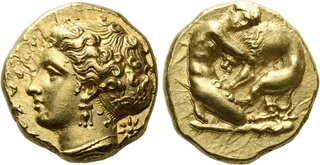| Numismatica Ars Classica > Auction 146 | Auction date: 8 May 2024 |
| Lot number: 2106 Price realized: This lot is for sale in an upcoming auction - Bid on this lot  | Show similar lots on CoinArchives Find similar lots in upcoming auctions on |
| Lot description: Syracuse. Double decadrachm or 100 litrae circa 405-400, AV 13 mm, 5.78 g. ΣΥΡΑΚΟΣIΟ Head of the nymph Arethusa l., wearing necklace, bar and triple-pendant earring; hair elaborately waved and caught up behind in saccos ornamented with stars. Behind head, star. Rev. Naked young Heracles kneeling r. on rocky ground, head to front, strangling Nemean lion with both arms; on the strip of ground, barley grain. Rizzo pl. LIII, 11 (these dies). Gillet 701 (these dies). Gulbenkian 325 (these dies). Dewing 926 (these dies). Bérend, Denys I, 38.12 (this coin). Rare. A portrait of superb style struck in high relief. An almost invisible mark on chin, otherwise good extremely fine Ex Ars Classica sale XII, 1926, 932. Before this series, gold coinage in the Western Mediterranean was episodic, and was only issued in times of emergency. Syracuse had traditionally set trends for coinage in Sicily, so it comes as no surprise that it led the way on the issuance of gold. The need for gold coinage in such quantity must have been military, and we can speculate that these coins were used to pay the mercenaries who Dionysios I hired to promote his ambitions. This coinage was probably introduced sometime around 400 B.C. and appears to have been struck in parallel with the silver decadrachms of the Kimon and Euainetos types. Though the precise date of this gold coinage is not known, the best opinions range from c. 406 to c. 390 B.C. as the starting point, and c. 370/65 B.C. as the end. Of particular value in establishing the context of this coinage are the Avola Hoards (ICGH 2122 and 2124) found not far south of Syracuse, which contained examples of this type in superb condition. Since other gold coins were found with them, including Persian darics and Lampsacus staters, these hoards probably were deposited by c. 370 or 360 B.C. Dozens of military actions are spread over the decades of Dionysius' reign, so it is impossible to isolate one that explains the genesis of this series. However, a theory was put forth by Boehringer, who associated these coins with Dionysius' great victory over the besieging Carthaginians in 396 or 395. He suggested that because the Carthaginians were routed at their encampment on the plain at the Anapus river, to the south of Syracuse, it was meaningful that the half-denomination of this series, the gold decadrachm (50-litra), portrays the river-god Anapus. Perhaps fortifying this idea is a report by Diodorus (14.75.1-3) that Dionysius collected 300 talents from the Carthaginian commander Himilco as a term of surrender after the defeat. That influx may have been converted into coinage to pay his troops. It is not clear why the Heracles-and-lion type was introduced with this issue, though it may be emblematic of the Greek struggle against the Carthaginians, with the lion being symbolic of that culture. Estimate: 15000 CHF |  |



